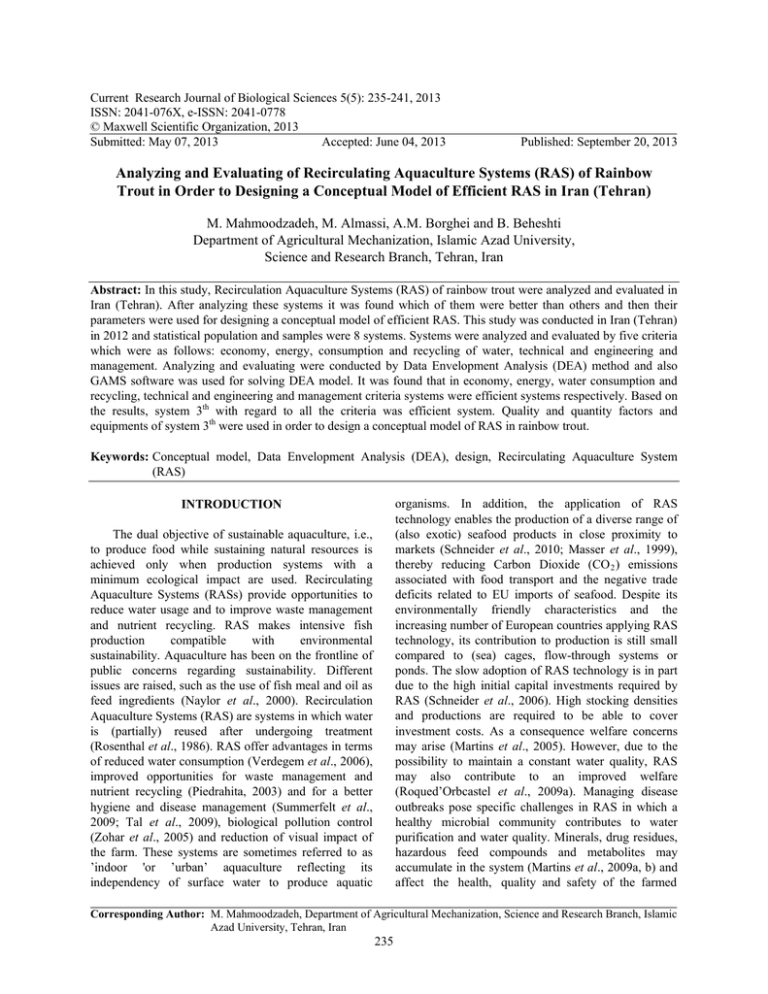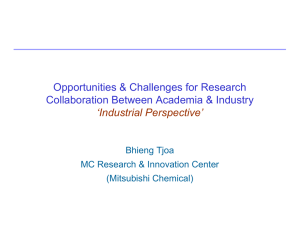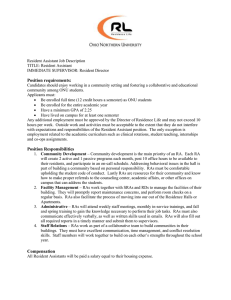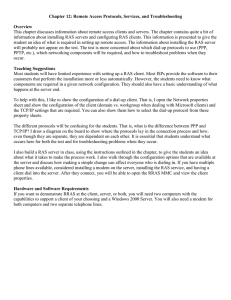Current Research Journal of Biological Sciences 5(5): 235-241, 2013
advertisement

Current Research Journal of Biological Sciences 5(5): 235-241, 2013
ISSN: 2041-076X, e-ISSN: 2041-0778
© Maxwell Scientific Organization, 2013
Submitted: May 07, 2013
Accepted: June 04, 2013
Published: September 20, 2013
Analyzing and Evaluating of Recirculating Aquaculture Systems (RAS) of Rainbow
Trout in Order to Designing a Conceptual Model of Efficient RAS in Iran (Tehran)
M. Mahmoodzadeh, M. Almassi, A.M. Borghei and B. Beheshti
Department of Agricultural Mechanization, Islamic Azad University,
Science and Research Branch, Tehran, Iran
Abstract: In this study, Recirculation Aquaculture Systems (RAS) of rainbow trout were analyzed and evaluated in
Iran (Tehran). After analyzing these systems it was found which of them were better than others and then their
parameters were used for designing a conceptual model of efficient RAS. This study was conducted in Iran (Tehran)
in 2012 and statistical population and samples were 8 systems. Systems were analyzed and evaluated by five criteria
which were as follows: economy, energy, consumption and recycling of water, technical and engineering and
management. Analyzing and evaluating were conducted by Data Envelopment Analysis (DEA) method and also
GAMS software was used for solving DEA model. It was found that in economy, energy, water consumption and
recycling, technical and engineering and management criteria systems were efficient systems respectively. Based on
the results, system 3th with regard to all the criteria was efficient system. Quality and quantity factors and
equipments of system 3th were used in order to design a conceptual model of RAS in rainbow trout.
Keywords: Conceptual model, Data Envelopment Analysis (DEA), design, Recirculating Aquaculture System
(RAS)
organisms. In addition, the application of RAS
technology enables the production of a diverse range of
(also exotic) seafood products in close proximity to
markets (Schneider et al., 2010; Masser et al., 1999),
thereby reducing Carbon Dioxide (CO 2 ) emissions
associated with food transport and the negative trade
deficits related to EU imports of seafood. Despite its
environmentally friendly characteristics and the
increasing number of European countries applying RAS
technology, its contribution to production is still small
compared to (sea) cages, flow-through systems or
ponds. The slow adoption of RAS technology is in part
due to the high initial capital investments required by
RAS (Schneider et al., 2006). High stocking densities
and productions are required to be able to cover
investment costs. As a consequence welfare concerns
may arise (Martins et al., 2005). However, due to the
possibility to maintain a constant water quality, RAS
may also contribute to an improved welfare
(Roqued’Orbcastel et al., 2009a). Managing disease
outbreaks pose specific challenges in RAS in which a
healthy microbial community contributes to water
purification and water quality. Minerals, drug residues,
hazardous feed compounds and metabolites may
accumulate in the system (Martins et al., 2009a, b) and
affect the health, quality and safety of the farmed
INTRODUCTION
The dual objective of sustainable aquaculture, i.e.,
to produce food while sustaining natural resources is
achieved only when production systems with a
minimum ecological impact are used. Recirculating
Aquaculture Systems (RASs) provide opportunities to
reduce water usage and to improve waste management
and nutrient recycling. RAS makes intensive fish
production
compatible
with
environmental
sustainability. Aquaculture has been on the frontline of
public concerns regarding sustainability. Different
issues are raised, such as the use of fish meal and oil as
feed ingredients (Naylor et al., 2000). Recirculation
Aquaculture Systems (RAS) are systems in which water
is (partially) reused after undergoing treatment
(Rosenthal et al., 1986). RAS offer advantages in terms
of reduced water consumption (Verdegem et al., 2006),
improved opportunities for waste management and
nutrient recycling (Piedrahita, 2003) and for a better
hygiene and disease management (Summerfelt et al.,
2009; Tal et al., 2009), biological pollution control
(Zohar et al., 2005) and reduction of visual impact of
the farm. These systems are sometimes referred to as
’indoor 'or ’urban’ aquaculture reflecting its
independency of surface water to produce aquatic
Corresponding Author: M. Mahmoodzadeh, Department of Agricultural Mechanization, Science and Research Branch, Islamic
Azad University, Tehran, Iran
235
Curr. Res. J. Biol. Sci., 5(5): 235-241, 2013
animal. How these different factors interact and
influence the fish and the various purification reactors
is still poorly understood. Furthermore, RAS
historically developed producing freshwater fish
species that are rather tolerant to poor water quality.
The expansion of RAS being used for the production of
marine and brackish water species often focuses on
hatchery operations which pose extra requirements on
water quality and require further innovations in RAS
technology.
Most of the non-parametric applications are based
on the DEA (Data Envelopment Analysis) model as
proposed by Charnes et al. (1978). In recent years,
DEA has become a central technique in productivity
and efficiency analysis, applied in different aspects of
economics and management sciences. DEA models are
linear programming methods that calculate the frontier
production function of a set of Decision-Making Units
(DMUs) and evaluate the relative technical efficiency
of each unit, thereby allowing a distinction to be made
between efficient and inefficient DMUs. Those
identified as ‘‘best practice units’’ (i.e., those
determining the frontier) are given a rating of one,
whereas the degree of technical inefficiency of the rest
is calculated on the basis of the Euclidian distance of
their input-output ratio from the frontier (Coelli et al.,
1998). DEA has been used in comparing organizations
(Athanassopoulos and Shale, 1997; Abbott and
Doucouliagos, 2003; Sheldon, 2003), firms (Fa¨re et al.,
1996; Chen and Ali, 2004) and regions or countries
(Karkazis and Thanassoulis, 1998). In agriculture, DEA
has also been applied to studies of various products
ranging from horticulture and cotton to aquaculture
(Shafiq and Rehman, 2000; Sharma et al., 1999a;
Iraizoz et al., 2003). A further comparative review of
frontier studies on agricultural products can be found in
Thiam et al. (2001). Applications in assessing the
efficiency of livestock farms are growing (Cloutier and
Rowley, 1993; Fraserand Cordina, 1999; Reinhard
et al., 2000) but they are mostly focused on dairy farms.
A key question arising from frontier analysis is whether
it is possible to determine common characteristics
among best practice units. Existence of such
characteristics implies that a certain pattern (behavioral
and/or managerial personal characteristics) can be
associated with efficiency levels and its influence on
farm performance assessed. In the literature, numerous
empirical studies attempt to explain variation in the
success of farms by regressing efficiency scores on a
set of explanatory variables. Most studies concentrate
on the influence of personal characteristics such as age,
education, experience and specialization, or physical
aspects such as farm size and certain input usage
(Iraizoz et al., 2003; Sharma et al., 1999b; Lansink and
Reinhard, 2004; Fousekis et al., 2001a, b; Wilson
et al., 2001). The remainder of the study is organized as
follows: In the following section DEA methodology is
discussed and the applied model is presented. Results
are presented and discussed subsequently, while
concluding remarks are given in the final section.
In this study, analyzing and evaluating of Recirculating Aquaculture Systems (RAS) of Rainbow
Trout will conduct. This analyzing and evaluating will
be conducted by five criteria which are included
economy, energy, consumption and recycling of water,
technical and engineering and management and each
criterion is divided into sub-criterion. Efficient and
inefficient systems in each criterion and also in term of
all the criteria will be designated after analyzing and
evaluating all the Re-circulating Aquaculture Systems
(RAS) which are on the study. At the end, a conceptual
model of Re-circulating Aquaculture Systems (RAS) of
rainbow trout in Iran (Tehran) will be designed and
developed base on the quality and quantity factors and
the equipments of the efficient system.
5T
5T8
5T8
5T
5T
5T
8T
5T8
5T
MATERIALS AND METHODS
A conceptual model have been designed and
developed in order to better understanding of all the
research steps. A complete understanding of all phases
of this study will be obtained by reading top-down a
conceptual model (Fig. 1). Non-radial model in Data
Envelopment Analysis (DEA) method has been used in
analyzing and evaluating that will be seen after showing
the conceptual model.
Decision Making Units (DMU S ) have been shown
for 5 criteria as follows economy, energy, water
consumption and recycling, technical and engineering
and management in the Table 1. Inputs and outputs of
each DMU S have been shown as x and y (Table 1) and
then they used in non-radial model Eq. (1) as x and y of
equations. This table is formed for all the 8 systems and
analyzing and evaluating were done base on
information of this table and DEA model.
R
R
R
R
Non-radial model in Data Envelopment Analysis
method (DEA): In order to evaluating Decision
Making Units (DMU s ) the following model is
considered in which each input and output will be
modified by independent ratio Eq. (1):
R
1
𝑀𝑀𝑀𝑀𝑀𝑀 𝑅𝑅𝑅𝑅 = 1𝑚𝑚
s
∑𝑚𝑚
i=1 θi
∑𝑠𝑠r =1 φr
R
𝑠𝑠. 𝑡𝑡. ∑𝑛𝑛𝑗𝑗=1 𝜆𝜆𝑗𝑗 𝑥𝑥ij ≤ 𝜃𝜃i 𝑥𝑥i0 𝑖𝑖 = 1,2, … , 𝑚𝑚
∑𝑛𝑛j=1 λj 𝑦𝑦𝑟𝑟𝑟𝑟 ≥ 𝜑𝜑𝑟𝑟 𝑦𝑦r0 , 𝑟𝑟 = 1,2, … , 𝑠𝑠
θi ≤ 1 , 𝑖𝑖 = 1,2, … , 𝑚𝑚
𝜑𝜑r ≥ 1 , 𝑟𝑟 = 1,2, … , 𝑠𝑠
𝜆𝜆j ≥ 0 , 𝑗𝑗 = 1,2, … , 𝑛𝑛
(1)
The non-radial model Eq. (1) must be solved for all
the RAS in the case study area (Iran). In this study
should be considered that:
236
Curr. Res. J. Biol. Sci., 5(5): 235-241, 2013
Fig. 1: A conceptual model of the research steps
Table 1: Table of DMU s (Decision Making Units)
DMU s (Decision Making Units)
-------------------------------------------------------------------------------------------------------------------------------------------------------------------------------Number
Criteria
Inputs (x)
Outputs (y)
1
Economy
1. Labor cost
1. Income
2. Electricity cost
3. Cost of fish food
4. Cost of baby fish
5. Oxygen cost
6. Cost of medicine and vitamin
7. Maintenance cost
2
Energy
1. Energy of labor
1. Income
2. Energy of electricity
2. Fish production
3. Baby fish production
3
Water consumption and recycling
1. Flow rate of input water
1. Replacement
2. Circulate rate of water
frequency of water
3. Total water in the system
per day
4. Tonnage of fish in the system
4
Technical and engineering
1. Pond geometry
1. Income
2. Pond volume
2. Fish production
3. Number of pond
3. Baby fish production
4. Type of mechanical filter
5. Capacity of mechanical filter
6. Type of bio-filter
7. Surface of bio-filter
8. Number of water pump
9. Disinfection system
5
Management
1. Distance to market or city
1. Income
2. Educational background
2. Mortality rate
3. Experience of staff
3. Fish production
4. Passing training courses
4. Baby fish production
5. Nominal production capacity
6. Consumption of fish food
7. Qualified staff
237
Curr. Res. J. Biol. Sci., 5(5): 235-241, 2013
Table 2: Table of showing efficiency rate of systems for each criterion and also all the criteria
Criteria
-----------------------------------------------------------------------------------------------------------------------------------------------------Consumption and
Technical
In terms of all
Systems
Economy
Energy
recycling of water
and engineering
Management
the criteria
System 1
0.430374
0.194545
1
0.111111
0.074556
0.343906
System 2
0.416232
0.250000
0.124594
0.111111
0.127801
0.187725
System 3
1
1
0.161831
1
1
0.668346
System 4
0.380479
0.250000
0.115362
0.111111
0.128909
0.178950
System 5
0.668922
0.217557
0.162208
0.270000
1
0.419455
System 6
0.395932
0.194545
1
0.111111
0.074087
0.336923
System 7
0.606718
0.209440
0.195369
0.345556
1
0.414750
System 8
1
0.250000
0.100983
0.111111
0.066729
0.287542
𝑜𝑜 ∈ {𝑠𝑠𝑠𝑠𝑠𝑠𝑠𝑠𝑠𝑠𝑠𝑠 1, … , 𝑠𝑠𝑠𝑠𝑠𝑠𝑠𝑠𝑠𝑠𝑠𝑠 8}
After solving the model Eq. (1) the optimal value
of objective function (R*) will be found which means
the efficiency value of oth RAS. If Value of (R*) in
RAS would be 1 it is indicative of full efficiency of
RAS and also if it would be lesser than 1 it is indicative
of inefficiency of RAS. How much value of RAS
efficiency would be lesser than 1 is indicative of
inefficiency of RAS which means RAS that is under
analyzing and evaluating would be in bad situation in
term of evaluation criteria.
P
P
P
P
RESULTS AND DISCUSSION
Fig. 2: Diagram of showing efficiency ranking of each system
in term of all criteria
Non-radial model Eq. (1) designed for 8 RAS and
5 criteria in order to evaluate relative efficiency of 8
RAS by 5 criteria which include as follows economy,
energy, water consumption and recycling, technical and
engineering and management. Therefore results have
obtained by putting inputs and outputs values
(According to Table 2) instead of X and Y in non-radial
model Eq. (1) and solving it with GAMS software.
Based on the results as can be seen in the following
Table 2 in terms of economy, energy, consumption and
recycling of water, technical and engineering and
management criteria systems were designated efficient
systems respectively and also in term of all the
(Verdegem et al., 2006; Schneider et al., 2010; Naylor
et al., 2000; Tal et al., 2009; Summerfelt et al., 2009;
Zohar et al., 2005) criteria system 3 was designated
efficient system.
As can be seen in Fig. 2 in term of all the criteria of
efficiency first, second, third, fourth, fifth, sixth,
seventh and eighth ranking are belonged to systems
(Verdegem et al., 2006; Summerfelt et al., 2009; Zohar
et al., 2005; Naylor et al., 2000; Tal et al., 2009;
Schneider et al., 2010; Rosenthal et al., 1986) and
Piedrahita (2003) respectively. Based on the results first
ranking is allocated to system 3th.
As can be seen in Fig. 3 a conceptual model of
efficient Re-circulating Aquaculture Systems (RAS) of
rainbow trout in Iran (Tehran) is designed and
developed. This model is formed by three parts which
are quality and quantity factors and equipments and
also it should be expressed that each part includes other
different sections. Information contained in these parts
5T
of the conceptual model is obtained by analyzing all the
specifications of efficient system which are included by
quality and quantity factors and equipments. It should
be considered this conceptual model is designed and
developed based on the potential and relative efficiency
of economy, energy, consumption and recycling of
water, technical and engineering and management
criteria of exciting RAS in Iran (Tehran).
5T
CONCLUSION
In this study a conceptual model of efficient Recirculating Aquaculture System (RAS) of rainbow trout
in Iran (Tehran) was designed and developed. At first,
in order to designing a conceptual model it was
necessary to identify all the quality and quantity factors
and equipments of efficient RAS. Therefore were
identified and evaluated all the RAS in Iran (case study:
Tehran). In this study Data Envelopment Analysis
(DEA) was very effective method in analyzing system
because it could consider all the quality and quantity
factors simultaneously. This conceptual model could be
as an effective means to develop remote areas where
growth and development potential have. Accordingly, it
is suggested that Agriculture Ministry boosts Fisheries
Organization in order to introduce RAS in Iran as a new
technology and effective means to convert fish breeding
from a non-industrial level into an industrial level.
Subsequently, government as to provide support
5T
5T
5T
P
P
5T
5T8
5T
5T8
5T
5T
238
Curr. Res. J. Biol. Sci., 5(5): 235-241, 2013
Fig. 3: Conceptual modal of designing efficient Re-circulating Aquaculture System (RAS) in Iran (Tehran)
Athanassopoulos, A. and E. Shale, 1997. Assessing the
comparative efficiency of higher education
institutions in the UK by means of data
envelopment analysis. Educ. Econ., 5(2): 117-134.
Charnes, A., W.W. Cooper and E. Rhodes, 1978.
Measuring the efficiency of decision making units.
Eur. J. Oper. Res., 2: 429-444.
Chen, Y. and A.I. Ali, 2004. DEA Malmquist
productivity measure: New insights with an
application tocomputer industry. Eur. J. Oper. Res.,
159(1): 239-249.
Cloutier, L.M. and R. Rowley, 1993. Relative technical
efficiency: Data envelopment analysis and
Quebec_sdairy farms. Can. J. Agric. Econ., 41:
169-176.
Coelli, T., D.S. Prasada Rao and G.E. Battese, 1998. An
Introduction to Efficiency and Productivity
Analysis.
Kluwer
Academic
Publishers,
Massachusetts.
packages for developing and extending this technology
in Iran and also they could provide mechanization and
modernization in fish production systems.
5T
5T
ACKNOWLEDGMENT
The authors would like to acknowledge the
scientific support with dear doctors Farhad
HossinzadehLotfi and Hossien Bakhoda. The authors
would like to thank of dedicated staff of Iran Fisheries
Organization for making available the data collecting
and their kind support.
REFERENCES
Abbott, M. and C. Doucouliagos, 2003. The efficiency
of Australian universities: A data envelopment
analysis. Econ. Educ. Rev., 22(1): 89-97.
239
Curr. Res. J. Biol. Sci., 5(5): 235-241, 2013
Reinhard, S., K.C.A. Lovell and G.J. Thijssen, 2000.
Environmental
efficiency
with
multiple
environmentallydetrimental variables; estimated
with SFA and DEA. Eur. J. Oper. Res., 121:
287-303.
Roqued’Orbcastel, E., J. Person-Le-Ruyet, N. Le Bayon
and J.P. Blancheton, 2009a. Comparative growth
and welfare in rainbow trout reared in recirculating and flow through rearing systems.
Aquacult. Eng., 40: 79-86.
Rosenthal, H., J.D. Castell, K. Chiba, J.R.M. Forster,
V.Hilge, H. Hogendoorn, R.D. Mayo, J.F. Muir,
K.R. Murray, J. Petit, G.A. Wedemeyer,
F. Wheaton and J. Wickins, 1986. Flow-through
and Recirculation Systems. EIFAC Technical
Paper No. 49, pp: 100.
Schneider, O., J.P. Blancheton, L. Varadi, E.H. Eding
and J.A.J. Verreth, 2006. Cost price and production
strategies in European recirculation systems.
Linking Tradition and Technology Highest Quality
for the Consumer, Firenze, Italy, WAS.
Schneider, O., E. Schram, M. Poelman, A. Rothuis,
A. van Duijn and H. van der Mheen, 2010.
Practices in managing finfish aquaculture using ras
technologies, the Dutch example. Proceeding of the
OECD Workshop on Advancing the Aquaculture
Agenda, Paris, France, OECD.
Shafiq, M. and M. Rehman, 2000. The extent of
resource use inefficiencies in cotton production in
Pakistan_s Punjab: An application of data
envelopment analysis. Agric. Econ., 22: 321-330.
Sharma, K.R., P.S. Leung, H. Chen and A. Peterson,
1999a. Economic efficiency and optimum
stockingdensities in fish polyculture: An
application of Data Envelopment Analysis (DEA)
to Chinese fish farms. Aquaculture, 180:
207-221.
Sharma, K.R., P.S. Leung and H.M. Zaleski, 1999b.
Technical, allocative and economic efficiencies in
swineproduction in Hawaii: A comparison of
parametric and nonparametric approaches. Agric.
Econ., 20: 23-35.
Sheldon, G.M., 2003. The efficiency of public
employment services: A nonparametric matching
functionanalysis for Switzerland. J. Prod. Anal.,
20: 49-70.
Summerfelt, S.T., M.J. Sharrer, S.M. Tsukuda and
M. Gearheart, 2009. Process requirements for
achieving full-flow disinfection of recirculating
water using ozonation and UV irradiation.
Aquacult. Eng., 40: 17-27.
Tal, Y., H.J. Schreier, K.R. Sowers, J.D. Stubblefield,
A.R. Place and Y. Zohar, 2009. Environmentally
sustainable land-based marine aquaculture.
Aquaculture, 286: 28-35.
Thiam, A., B.E. Bravo-Ureta and T.E. Rivas, 2001.
Technical efficiency in developing country
agriculture: Ameta-analysis. Agric. Econ., 25:
235-243.
Fa¨re, R., S. Grosskopf and D. Tyteca, 1996. An
activity analysis model of the environmental
performance of firms–application to fossil-fuelfired electric utilities. Ecol. Econ., 18: 161-175.
Fousekis, P., P. Spathis and K. Tsimboukas, 2001a.
Assessing the efficiency of sheep farming in
mountainousareas of Greece. A non-parametric
approach. Agric. Econ. Rev., 2(2): 515.
Fousekis, P., P. Spathis and K. Tsimboukas, 2001b.
Assessing the efficiency of sheep farming in
mountainousareas of Greece. A non-parametric
approach. Agric. Econ. Rev., 2(2): 515.
Fraser, I. and D. Cordina, 1999. An application of data
envelopment analysis to irrigated dairy farms
inNorthern Victoria, Australia. Agric. Syst., 59:
267-282.
Iraizoz, B., M. Rapun and I. Zabaleta, 2003. Assessing
the technical efficiency of horticultural production
inNavarra, Spain. Agric. Syst., 78: 387-403.
Karkazis, J. and E. Thanassoulis, 1998. Assessing the
effectiveness of regional development policies in
Northern Greece using data envelopment analysis.
Socio-Econ. Plan. Sci., 32(2): 123-137.
Lansink, A.O. and S. Reinhard, 2004. Investigating
technical efficiency and potential technological
change in Dutch pig farming. Agric. Syst., 79:
353-367.
Martins, C.I.M., E.H. Eding, O. Schneider,
R. Rasmussen, B. Olesen, L. Plesner and
J.A.J. Verreth, 2005. Recirculation Aquaculture
Systems in Europe. CONSENSUS, Consensus
Working Group, European Aquaculture Society,
Oostende, Belgium, pp: 31.
Martins, C.I.M., M.G. Pistrin, S.S.W. Ende, E.H. Eding
and J.A.J. Verreth, 2009a. The accumulation of
substances in Recirculating Aquaculture Systems
(RAS) affects embryonic and larval development
in common carp Cyprinus carpio. Aquaculture,
291: 65-73.
Martins, C.I.M., D. Ochola, S.S.W. Ende, E.H. Eding
and J.A.J. Verreth, 2009b. Is growth retardation
present in Nile tilapia Oreochromisniloticus
cultured in low water exchange recirculating
aquaculture systems? Aquaculture, 298: 43-50.
Masser, M.P., J. Rakocy and T.M. Losordo, 1999.
Recirculating aquaculture tank production systems:
Management of recirculating systems. SRAC
Publication No. 452, pp: 12.
Naylor, R.L., R.J. Goldburg, J.H. Primavera,
N. Kautsky, M.C.M. Beveridge, J. Clay, C. Folke,
J. Lubchenco, H. Mooney and M. Troell, 2000.
Effect of aquaculture on world fish supplies.
Nature, 405: 1017-1024.
Piedrahita, R.H., 2003. Reducing the potential
environmental
impact of tank aquaculture
effluents through intensification and recirculation.
Aquaculture, 226: 35-44.
240
Curr. Res. J. Biol. Sci., 5(5): 235-241, 2013
Verdegem, M.C.J., R.H. Bosma and J.A.J. Verreth,
2006. Reducing water use for animal production
through aquaculture. Int. J. Water Resour. Dev.,
22: 101-113.
Wilson, P., D. Hadley and C. Asby, 2001. The
influence of management characteristics on the
technicalefficiency of wheat farmers in eastern
England. Agric. Econ., 24: 329-338.
Zohar, Y., Y. Tal, H.J. Schreier, C. Steven,
J. Stubblefield and A. Place, 2005. Commercially
Feasible
Urban
Recirculated
Aquaculture:
Addressing the Marine Sector. In: Costa- Pierce,
B. (Ed.), Urban Aquaculture. CABI Publishing,
Cambridge, MA, pp: 159-171.
241







